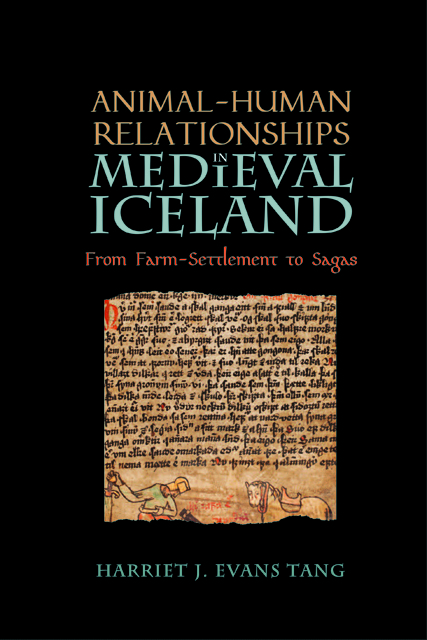Book contents
- Frontmatter
- Dedication
- Contents
- List of Illustrations
- Acknowledgements
- Note on Translations
- The Animal Acts …
- 1. An Animal-Human Settlement
- 2. Home, Sweet Home: Meeting Points on the Animal-Human Farm
- 3. The Animal-Human Community: Legal Tradition in Iceland
- 4. Fostering Relations: The Animal-Human Home in the Íslendingasögur
- 5. The Negative Animal: Absence, Precarity, and Danger
- … And the Man Responds
- Bibliography
- Index
- Nature and Environment in the Middle Ages
1. - An Animal-Human Settlement
Published online by Cambridge University Press: 11 January 2023
- Frontmatter
- Dedication
- Contents
- List of Illustrations
- Acknowledgements
- Note on Translations
- The Animal Acts …
- 1. An Animal-Human Settlement
- 2. Home, Sweet Home: Meeting Points on the Animal-Human Farm
- 3. The Animal-Human Community: Legal Tradition in Iceland
- 4. Fostering Relations: The Animal-Human Home in the Íslendingasögur
- 5. The Negative Animal: Absence, Precarity, and Danger
- … And the Man Responds
- Bibliography
- Index
- Nature and Environment in the Middle Ages
Summary
In the story of medieval Icelanders and their animals, we could do no better than to start at the beginning. The settlement of Iceland is, both materially and textually, an embodiment of human and animal relations with a new land. To properly begin to understand the ideas around and practicalities of settlement, we must consider both archaeological remains and theories, as well as later textual narratives about these settlement processes. This chapter focusses on the presentation and use of animals and space in material and literary narratives of the settlement of Iceland. Out of this drawing together of multidisciplinary sources and methods, the idea of the settlement of Iceland as a co-settlement emerges: a settlement reliant on mutual care and cooperation, and the apparent mediatory role of animals between humans and their new land.
Domestic animals in Iceland occupy a distinctive place in the settlement of the island. While the island was not empty when settlers arrived in the ninth century, having pre-existing populations of arctic fox and migratory birds, all domestic animals in Viking-Age Iceland were brought over by migrants and required to work alongside their human partners in co-settling the landscape. The physical presence of domestic animals in the Icelandic landscape was therefore part of the Iceland constructed by these settlers and re-created by medieval writers. By building farms and boundaries, clearing land, and naming places, the settlers created homelands out of the Icelandic environment, and wrote the terms of their society: terms in which domestic animals played a formative part.
How to Access the Settlement?
A multitude of narratives exist surrounding the settlement of Iceland, with previous scholarly debates having been dominated by those narratives found in Old Norse-Icelandic written sources, especially Íslendingabók (the Book of the Icelanders) and Landnámabók (the Book of Settlements), and archaeological methods have been used to confirm these narratives. In recent decades, however, archaeologists studying settlement-era Iceland have questioned the dominance of medieval texts in shaping our views and, as a result, competing narratives of settlement have emerged, relying on detailed and extensive archaeological investigation. For example, some theories rely on intensive and organised ferrying of migrants to Iceland to set up farms from the earliest stages of settlement, while some emphasise the early actions of walrus-hunters in the region.
- Type
- Chapter
- Information
- Animal-Human Relationships in Medieval IcelandFrom Farm-Settlement to Sagas, pp. 23 - 59Publisher: Boydell & BrewerPrint publication year: 2022



